Education Indicators in Canada: An International Perspective 2016
Chapter C
Access to education, participation and progression
Archived Content
Information identified as archived is provided for reference, research or recordkeeping purposes. It is not subject to the Government of Canada Web Standards and has not been altered or updated since it was archived. Please "contact us" to request a format other than those available.
C1 International students
Context
This indicator presents international students as a proportion of enrolment in tertiary education in accordance with the three International Standard Classification of Education (ISCED) categoriesNote 1, which represent enrolments in colleges and universitiesNote 2. Changes in the number of international students over time are also presented, as well as their distribution by province of study and by region of origin.
Students choose to pursue their education abroad for many reasons. Some may do so because they wish to explore different cultures, societies and languages while improving their employment prospects. Growing recognition of the importance of tertiary education as a determinant of higher earnings and employability has led to a growing demand, one that educational institutions in some countries may find difficult to meet. At the same time, the globalization of markets has increased demand for workers with broader knowledge and competencies, with work increasingly performed by teams that span regions and countries.
Several factors may contribute to the choice of country for study. The language spoken and used in instruction, the quality of education offered, the tuition fees and cost of living, and the immigration policy of the destination country are all important factors. Other factors include recognition of foreign degrees, future job opportunities, and any geographical, trade and cultural links between countries.
International students represent an additional source of revenue for the institutions they attend. They may also contribute to the viability of programs when the domestic student base is somewhat limited. In Canada, as in other countries that belong to the Organization for Economic Co-operation and Development (OECD), many institutions and governments are now actively marketing their educational programs to attract such students. In addition to the economic benefits they may provide, international and foreign students also add to the social and cultural dimensions of the communities in which they study. They may become future citizens, or they may become unofficial ambassadors when they return home.
Observations
International students in tertiary education
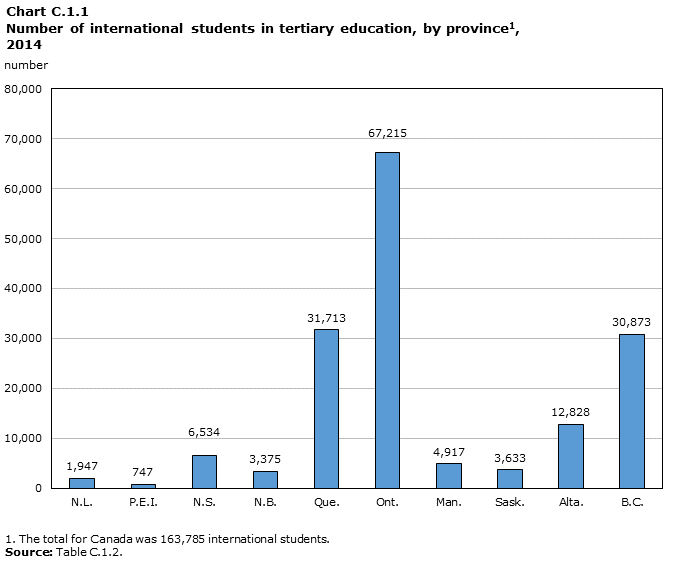
Data table for Chart C.1.1
| number | percentage | |
|---|---|---|
| N.L. | 1,947 | 1.2 |
| P.E.I. | 747 | 0.5 |
| N.S. | 6,534 | 4.0 |
| N.B. | 3,375 | 2.1 |
| Que. | 31,713 | 19.4 |
| Ont. | 67,215 | 41.0 |
| Man. | 4,917 | 3.0 |
| Sask. | 3,633 | 2.2 |
| Alta. | 12,828 | 7.8 |
| B.C. | 30,873 | 18.9 |
|
||
- In 2014, there were about 163,800 international students studying in Canada. Ontario attracted the largest proportion of international students (41%), followed by Quebec (19%) and British Columbia (19%).
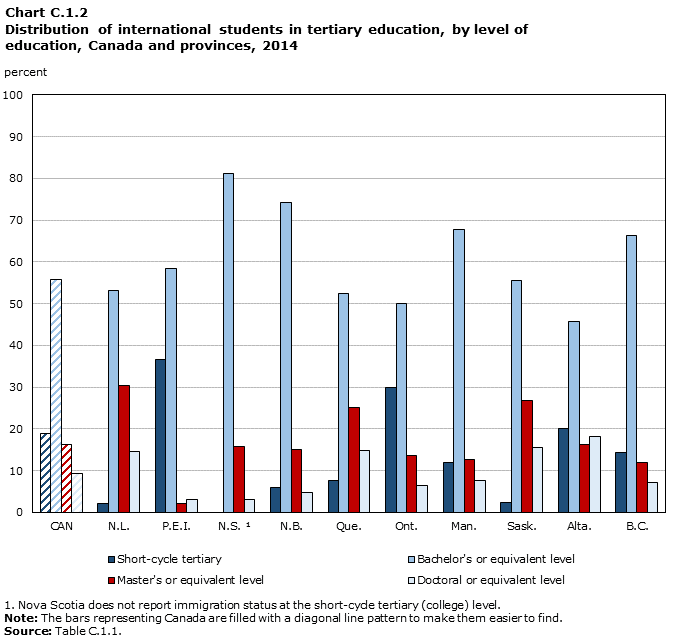
Data table for Chart C.1.2
| Short-cycle tertiary | Bachelor's or equivalent level | Master's or equivalent level | Doctoral or equivalent level | |
|---|---|---|---|---|
| percent | ||||
| CAN | 18.8 | 55.7 | 16.2 | 9.3 |
| N.L. | 2.1 | 53.1 | 30.4 | 14.5 |
| P.E.I. | 36.6 | 58.3 | 2.0 | 3.1 |
| N.S. Data table Note 1 | 0.0 | 81.1 | 15.8 | 3.0 |
| N.B. | 6.0 | 74.1 | 15.1 | 4.8 |
| Que. | 7.5 | 52.5 | 25.1 | 14.8 |
| Ont. | 30.0 | 50.0 | 13.5 | 6.5 |
| Man. | 12.0 | 67.8 | 12.6 | 7.6 |
| Sask. | 2.4 | 55.5 | 26.7 | 15.5 |
| Alta. | 20.1 | 45.6 | 16.2 | 18.1 |
| B.C. | 14.4 | 66.4 | 12.0 | 7.2 |
|
||||
- The majority of international students in tertiary education in Canada were registered in Bachelor’s or equivalent level programs. This was true for every province.
- The proportion of international students registered at the short-cycle tertiary level (college) varied greatly by province; accounting for about a third in Prince Edward Island (37%) and Ontario (30%) to only 2% in Newfoundland and Labrador, and Saskatchewan.
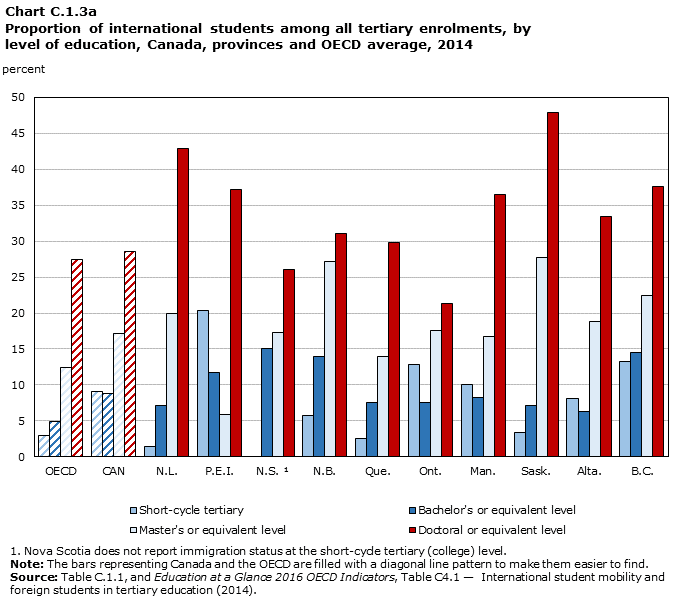
Data table for Chart C.1.3a
| Doctoral or equivalent level | Master's or equivalent level | Bachelor's or equivalent level | Short-cycle tertiary | Total teritiary | |
|---|---|---|---|---|---|
| percent | |||||
| OECD | 27.4 | 12.4 | 4.9 | 3.0 | 6.4 |
| CAN | 28.5 | 17.2 | 8.8 | 9.1 | 10.3 |
| N.L. | 42.9 | 20.0 | 7.1 | 1.5 | 9.4 |
| P.E.I. | 37.1 | 5.9 | 11.8 | 20.4 | 14.0 |
| N.S. Data table Note 1 | 26.1 | 17.3 | 15.0 | 0.0 | 13.5 |
| N.B. | 31.1 | 27.2 | 14.0 | 5.7 | 14.2 |
| Que. | 29.8 | 14.0 | 7.6 | 2.6 | 8.3 |
| Ont. | 21.3 | 17.5 | 7.5 | 12.8 | 9.9 |
| Man. | 36.5 | 16.8 | 8.3 | 10.1 | 9.7 |
| Sask. | 47.8 | 27.7 | 7.1 | 3.4 | 10.2 |
| Alta. | 33.4 | 18.8 | 6.3 | 8.1 | 9.0 |
| B.C. | 37.6 | 22.5 | 14.5 | 13.3 | 15.6 |
|
|||||
- While the proportion of international students in Canada for Doctoral or equivalent level programs (29%) is similar to the proportion observed for all OECD countries (27%), across provinces this proportion ranged from 21% in Ontario to 48% in Saskatchewan.
- The proportion of international students rose with the level of study at the university level (Bachelor’s, Master’s, and Doctoral levels), except in Prince Edward Island where the Bachelor’s level had a higher proportion of international students than at the Master’s level.
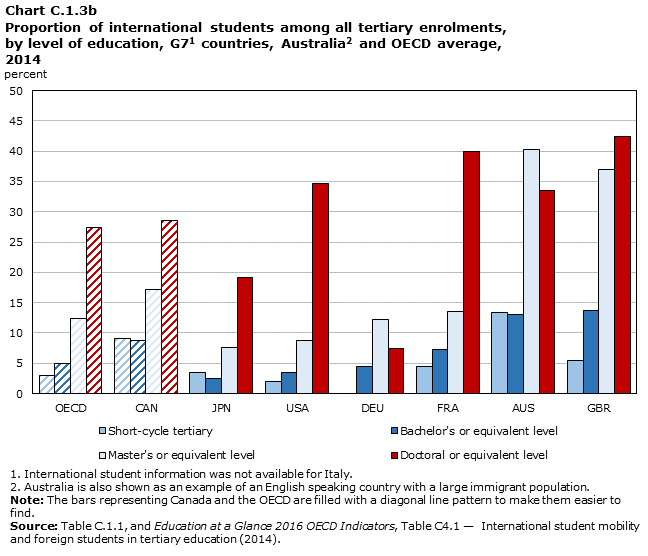
Data table for Chart C.1.3b
| Doctoral or equivalent level | Master's or equivalent level | Bachelor's or equivalent level | Short-cycle tertiary | Total teritiary | |
|---|---|---|---|---|---|
| percent | |||||
| OECD | 27.4 | 12.4 | 4.9 | 3.0 | 6.4 |
| CAN | 28.5 | 17.2 | 8.8 | 9.1 | 10.3 |
| JPN | 19.1 | 7.6 | 2.5 | 3.4 | 3.4 |
| USA | 34.7 | 8.8 | 3.5 | 2.0 | 4.2 |
| DEU | 7.4 | 12.2 | 4.4 | 0.0 | 7.2 |
| FRA | 39.9 | 13.5 | 7.3 | 4.4 | 9.8 |
| AUS | 33.5 | 40.2 | 13.1 | 13.3 | 18.3 |
| GBR | 42.5 | 36.9 | 13.7 | 5.5 | 18.2 |
|
|||||
- In comparison to other G7 countries, Canada had a higher proportion of international students than Germany and Japan at all education levels. The patterns for France, the United Kingdom and the United States were more similar to Canada’s, except that they all had much higher proportions at the doctoral level, and also for the master’s level in the United Kingdom.
- Australia, while not a G7 country was included for comparison because it also hosts large numbers of immigrants. In comparison to Canada, Australia had significantly higher proportions of international students at all levels of education.
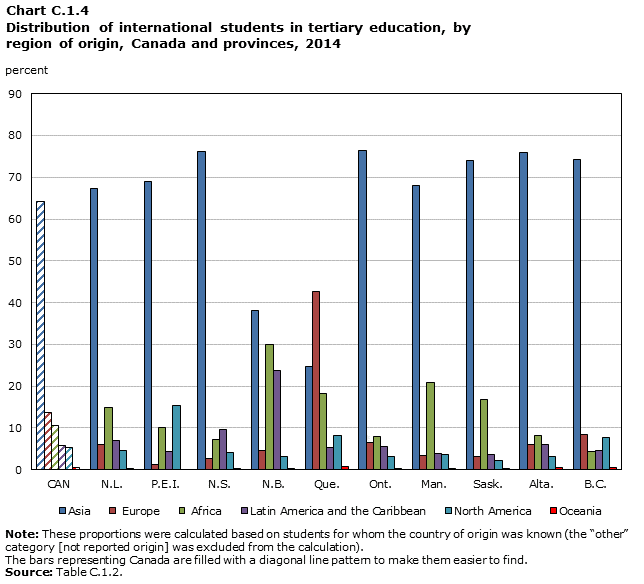
Data table for Chart C.1.4
| Asia | Europe | Africa | Latin America and the Caribbean | North America | Oceania | |
|---|---|---|---|---|---|---|
| percent | ||||||
| CAN | 64.2 | 13.7 | 10.5 | 5.9 | 5.2 | 0.5 |
| N.L. | 67.2 | 6.0 | 14.8 | 7.1 | 4.6 | 0.2 |
| P.E.I. | 69.0 | 1.2 | 10.1 | 4.4 | 15.3 | 0.0 |
| N.S. | 76.2 | 2.6 | 7.2 | 9.6 | 4.2 | 0.2 |
| N.B. | 38.2 | 4.6 | 30.0 | 23.7 | 3.2 | 0.4 |
| Que. | 24.8 | 42.6 | 18.3 | 5.3 | 8.2 | 0.8 |
| Ont. | 76.5 | 6.4 | 7.9 | 5.6 | 3.2 | 0.4 |
| Man. | 68.0 | 3.4 | 20.8 | 3.9 | 3.7 | 0.3 |
| Sask. | 73.9 | 3.2 | 16.9 | 3.6 | 2.1 | 0.4 |
| Alta. | 75.9 | 6.0 | 8.3 | 6.1 | 3.1 | 0.5 |
| B.C. | 74.2 | 8.5 | 4.3 | 4.6 | 7.8 | 0.6 |
|
Note: These proportions were calculated based on students for whom the country of origin was known (the “other” category [not reported origin] was excluded from the calculation). Source: Table C.1.2 |
||||||
- The majority of international students in Canada were from Asia (64%). Asia was the largest source region for every province except Quebec.
- In New Brunswick, while the primary region of origin was Asia, the proportion from that continent was significantly lower than most of the other provinces (38%). Notably, New Brunswick also had a fairly high proportion coming from Africa (30%).
- In Quebec, the largest source region was Europe (43%), followed by Asia (25%).
Definitions, sources and methodology
This indicator examines the proportion of international students in the different categories of tertiary education.
International students are those who are pursuing education in a country other than their country of residence or the country in which they were previously educated. In Canada, the concept of “international students” includes non-permanent residentsNote 3, such as those with a study permit. It also includes those enrolled in a Canadian program from a Canadian institution that is not located in Canada (also known as “offshore students”) as well as non-Canadian students studying via the Internet.
Foreign students correspond to a broader concept that includes students who are educated in a country for which they do not hold citizenship. In Canada, the concept of “foreign students” includes all “international students”, plus all students who are landed immigrant/permanent residentsNote 4.
The proportion of enrolment at a given education level by international students is obtained by dividing the number of students who are neither Canadian citizens nor permanent residentsNote 4 of Canada by the total number of students at that level, and multiplying this ratio by 100. The total number of students includes all individuals educated in Canada, whether they are Canadian citizens, permanent residents or foreign nationals as well as “off-shore students”, but it excludes all Canadian citizens and permanent residents who are educated abroad.
The Canadian data were drawn from Statistics Canada’s Postsecondary Student Information System (PSIS), which covers only public postsecondary institutions. Results for some jurisdictions rely in part on estimates made for non-responding institutions. Due to certain methodological adjustments that have been made to the PSIS collection tool to improve reporting and mapping to ISCED, comparisons of results with those from previous years should not be made.
The OECD data on foreign students and international students reflect the 2013/2014 academic year and are drawn from the UOE collection of statistical data on education, which was carried out by the OECD in 2015. In Canada and other OECD countries, domestic and international students are usually counted on a specific day or period of the year (e.g., the PSIS enrolment data reflect the number of students who were enrolled in courses between September 30 and December 1, 2013, for the academic year 2013/2014). This procedure may not capture the total number of international students as some students may study abroad for less than a full academic year (e.g., those that enter in the winter or spring terms).
Note: The corresponding OECD indicator is C4, Who studies abroad and where?
Tables for C1 International students
C2 Transitions to the labour market
Context
This indicator focuses on transitions from education to the working world. The percentages of individuals between 15 and 29 years of age who are considered to be “in education” or “not in education” are presented, along with their respective employment situations. Such information can be helpful in understanding how young adults may combine school and work, or how they may transition from one to the other. The “not in education” portion of this population is further examined with a focus on those individuals who are neither employed nor in education (or training), a group sometimes referred to as the “NEET” population.
In Canada and most other Organisation for Economic Co-operation and Development (OECD) countries, education policy-makers strive to encourage young people to complete at least their secondary education. As successfully reaching this milestone has become the norm for students in the majority of OECD countries, those who fail to do so will likely have much more difficulty when they enter the labour market, where lacking a high school education is usually an impediment to finding a job.
Recognition of the importance of postsecondary education for economic and social success—both for individuals and society—is widespread. However, the decisions that young people make regarding their education are often influenced by economic conditions. They may, for example, be inclined to leave school and enter the work force when the labour market is strong, or they may decide to continue with or return to their education when the labour market is weak and it is more difficult to find a job.
The transition from school to work is not always an easy process, and complexity may be added by a combination of factors including personal circumstances, the type and length of schooling received, and the labour market and overall economic conditions that younger people may face. It is also important to find ways to understand how this complexity may affect the NEET group, particularly the youngest members, as teens aged 15 to 19 will have both lower educational attainment and less work experience than young adults in their twenties.
Observations
Young adults in education, not in education
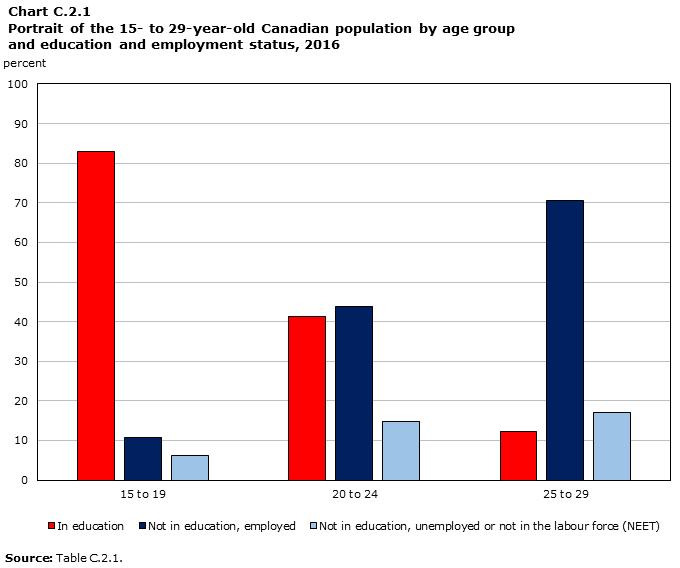
Data table for Chart C.2.1
| In education | Not in education, employed | Not in education, unemployed or not in the labour force (NEET) | |
|---|---|---|---|
| percent | |||
| 15 to 19 | 82.9 | 10.8 | 6.3 |
| 20 to 24 | 41.3 | 43.8 | 14.8 |
| 25 to 29 | 12.4 | 70.5 | 17.1 |
| Source: Table C.2.1. | |||
- In 2016, the majority of young Canadians aged 15 to 19 (83%) were in school. For young adults aged 20 to 24, similar proportions were noted between individuals who had transitioned to the labour market and were employed (44%) and those who were still in school (41%). For those in the 25- to 29-year-old age group, most (71%) were no longer in school and were employed.
- In 2016, the proportion of young Canadians “not in education, employment or training” (NEET) was higher for those aged 25 to 29 years (17%) than for those aged 20 to 24 years (15%) or 15 to 19 years (6%). This trend was also noted in the OECDNote 5 average and is observed year after year.
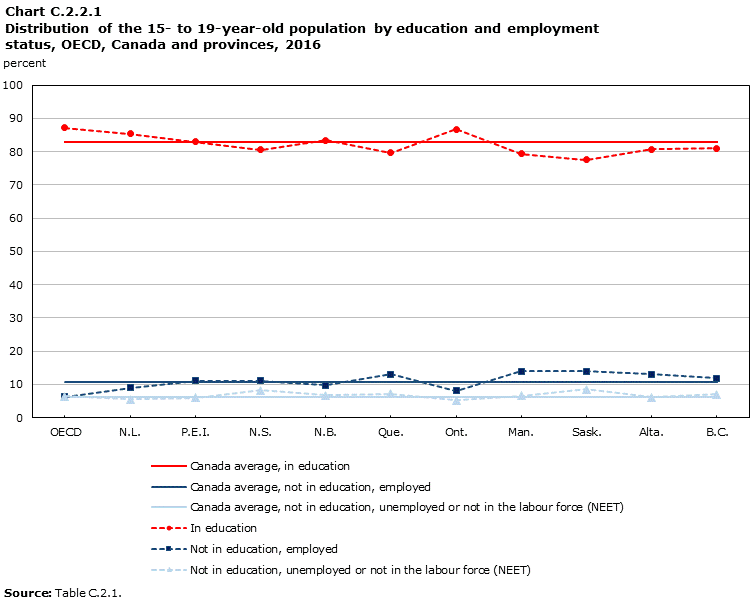
Data table for Chart C.2.2.1
| In education | Not in education, employed | Not in education, unemployed or not in the labour force (NEET) | Canada average, in education | Canada average, not in education, employed | Canada average, not in education, unemployed or not in the labour force (NEET) | |
|---|---|---|---|---|---|---|
| percent | ||||||
| OECD | 87.2 | 6.3 | 6.5 | 82.9 | 10.8 | 6.3 |
| Can. | 82.9 | 10.8 | 6.3 | 82.9 | 10.8 | 6.3 |
| N.L. | 85.4 | 9.0 | 5.6 | 82.9 | 10.8 | 6.3 |
| P.E.I. | 82.9 | 11.1 | 6.0 | 82.9 | 10.8 | 6.3 |
| N.S. | 80.6 | 11.1 | 8.3 | 82.9 | 10.8 | 6.3 |
| N.B. | 83.4 | 9.8 | 6.8 | 82.9 | 10.8 | 6.3 |
| Que. | 79.7 | 13.1 | 7.3 | 82.9 | 10.8 | 6.3 |
| Ont. | 86.7 | 8.1 | 5.2 | 82.9 | 10.8 | 6.3 |
| Man. | 79.3 | 14.0 | 6.7 | 82.9 | 10.8 | 6.3 |
| Sask. | 77.6 | 13.9 | 8.5 | 82.9 | 10.8 | 6.3 |
| Alta. | 80.7 | 13.1 | 6.2 | 82.9 | 10.8 | 6.3 |
| B.C. | 81.0 | 11.9 | 7.1 | 82.9 | 10.8 | 6.3 |
| Source: Table C.2.1. | ||||||
- In 2016, the majority of young Canadians aged 15 to 19 years (83%) were still studying, the same as the OECD average of 87%. For the provinces, this percentage varied from 78% in Saskatchewan to 87% in Ontario.
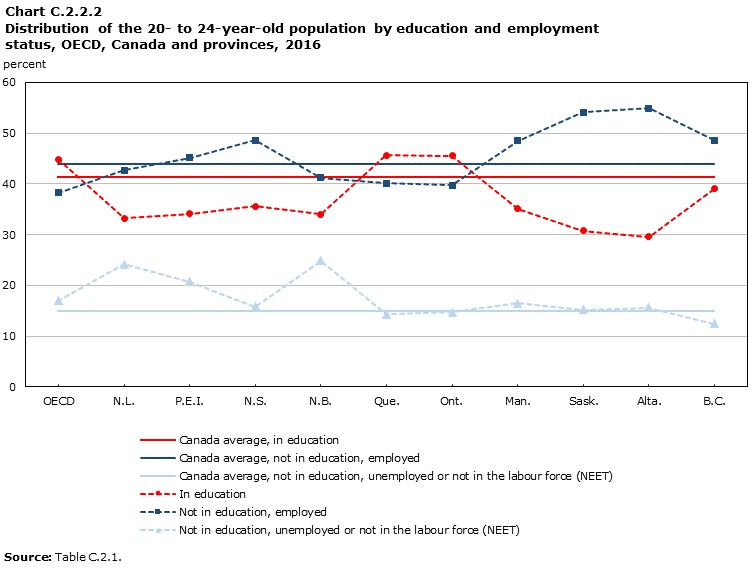
Data table for Chart C.2.2.2
| In education | Not in education, employed | Not in education, unemployed or not in the labour force (NEET) | Canada average, in education | Canada average, not in education, employed | Canada average, not in education, unemployed or not in the labour force (NEET) | |
|---|---|---|---|---|---|---|
| percent | ||||||
| OECD | 44.8 | 38.2 | 17.0 | 41.3 | 43.8 | 14.8 |
| Can. | 41.3 | 43.8 | 14.8 | 41.3 | 43.8 | 14.8 |
| N.L. | 33.2 | 42.7 | 24.1 | 41.3 | 43.8 | 14.8 |
| P.E.I. | 34.1 | 45.2 | 20.7 | 41.3 | 43.8 | 14.8 |
| N.S. | 35.6 | 48.6 | 15.8 | 41.3 | 43.8 | 14.8 |
| N.B. | 34.0 | 41.2 | 24.8 | 41.3 | 43.8 | 14.8 |
| Que. | 45.6 | 40.1 | 14.3 | 41.3 | 43.8 | 14.8 |
| Ont. | 45.5 | 39.7 | 14.7 | 41.3 | 43.8 | 14.8 |
| Man. | 35.1 | 48.5 | 16.5 | 41.3 | 43.8 | 14.8 |
| Sask. | 30.7 | 54.1 | 15.2 | 41.3 | 43.8 | 14.8 |
| Alta. | 29.6 | 54.9 | 15.5 | 41.3 | 43.8 | 14.8 |
| B.C. | 39.0 | 48.5 | 12.4 | 41.3 | 43.8 | 14.8 |
| Source: Table C.2.1. | ||||||
- At the national level, for young adults in the 20- to 24-year age group, similar percentages were observed between individuals who were employed (44%) and those who were in school (41%). The corresponding OECD averages were 38% and 45% respectively. These percentages varied more widely at the provincial level. In general, more young adults in this age group were employed than in school. This trend was observed in all provinces except Quebec and Ontario, where the situation was the reverse.
- The proportion of NEETs among 20- to 24-year-olds ranged from 12% in British Columbia to 25% in New Brunswick. The Canadian average was 15%, compared with 17% for the OECD average.
- For the NEET population aged 20 to 24, there was greater variation among the provinces than for NEETs in the other age groups (charts C.2.2.1 and C.2.2.3), which showed relatively similar distributions.
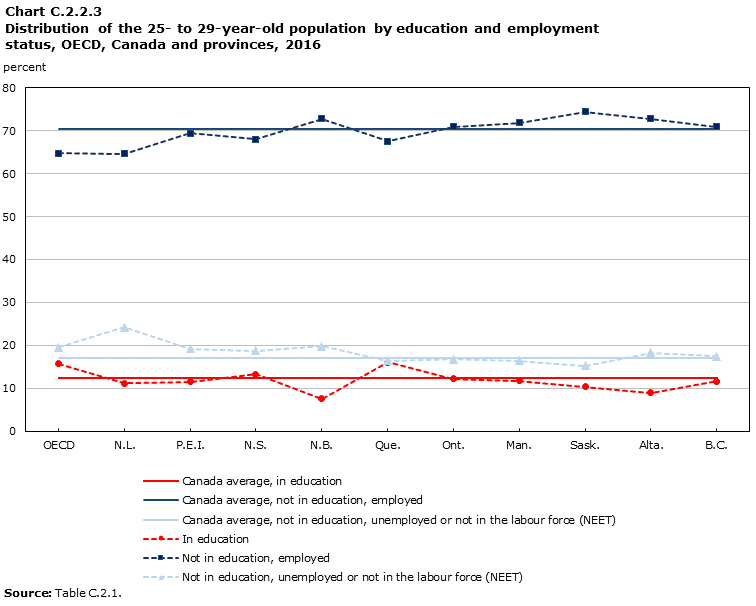
Data table for Chart C.2.2.3
| In education | Not in education, employed | Not in education, unemployed or not in the labour force (NEET) | Canada average, in education | Canada average, not in education, employed | Canada average, not in education, unemployed or not in the labour force (NEET) | |
|---|---|---|---|---|---|---|
| percent | ||||||
| OECD | 15.7 | 64.8 | 19.5 | 12.4 | 70.5 | 17.1 |
| Can. | 12.4 | 70.5 | 17.1 | 12.4 | 70.5 | 17.1 |
| N.L. | 11.2 | 64.7 | 24.2 | 12.4 | 70.5 | 17.1 |
| P.E.I. | 11.5 | 69.4 | 19.1 | 12.4 | 70.5 | 17.1 |
| N.S. | 13.2 | 68.0 | 18.8 | 12.4 | 70.5 | 17.1 |
| N.B. | 7.5 | 72.7 | 19.8 | 12.4 | 70.5 | 17.1 |
| Que. | 16.1 | 67.5 | 16.4 | 12.4 | 70.5 | 17.1 |
| Ont. | 12.2 | 71.0 | 16.8 | 12.4 | 70.5 | 17.1 |
| Man. | 11.7 | 71.9 | 16.4 | 12.4 | 70.5 | 17.1 |
| Sask. | 10.3 | 74.5 | 15.2 | 12.4 | 70.5 | 17.1 |
| Alta. | 8.9 | 72.8 | 18.3 | 12.4 | 70.5 | 17.1 |
| B.C. | 11.6 | 71.0 | 17.4 | 12.4 | 70.5 | 17.1 |
| Source: Table C.2.1. | ||||||
- In 2016, the majority (71%) of young Canadians aged 25 to 29 were no longer in school and were employed. The corresponding OECD average was 65%. Among the provinces, this proportion ranged from 65% in Newfoundland and Labrador to 75% in Saskatchewan.
- The highest rate of young NEETs was observed in the 25-to-29 age group: the Canadian average was 17% and provincial findings ranged from 15% in Saskatchewan to 24% in Newfoundland and Labrador. The corresponding OECD average was 20%.
Not employed, not in education (NEET)
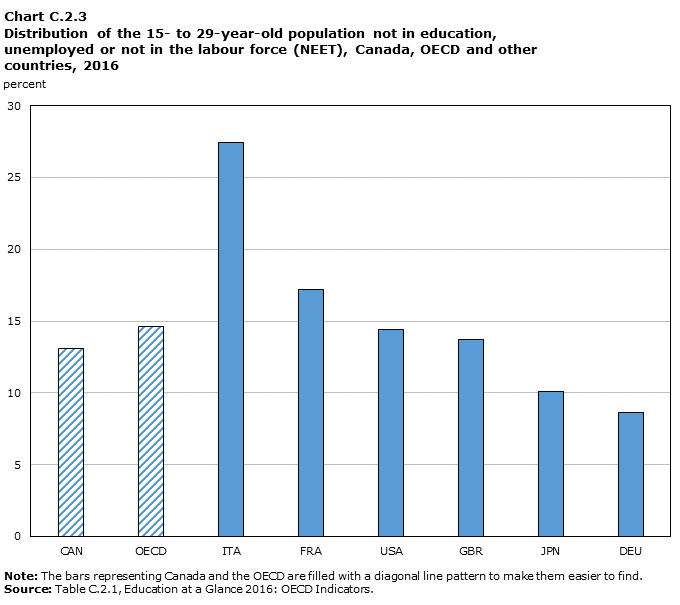
Data table for Chart C.2.3
| Not in education, unemployed or not in the labour force (NEET) | |
|---|---|
| percent | |
| CAN | 13.1 |
| OECD | 14.6 |
| ITA | 27.4 |
| FRA | 17.2 |
| USA | 14.4 |
| GBR | 13,7 |
| JPN | 10.1 |
| DEU | 8.6 |
|
Source: Table C.2.1, Education at a Glance 2016: OECD Indicators. |
|
- In 2016, 13% of Canadians 15 to 29 years were not in education, employment or training (NEET). This rate compares with the OECD average of 15%. However, there is a greater variability between individual countries. Among the G7 countries, this rate varied from 9% for Germany to 27% for Italy.
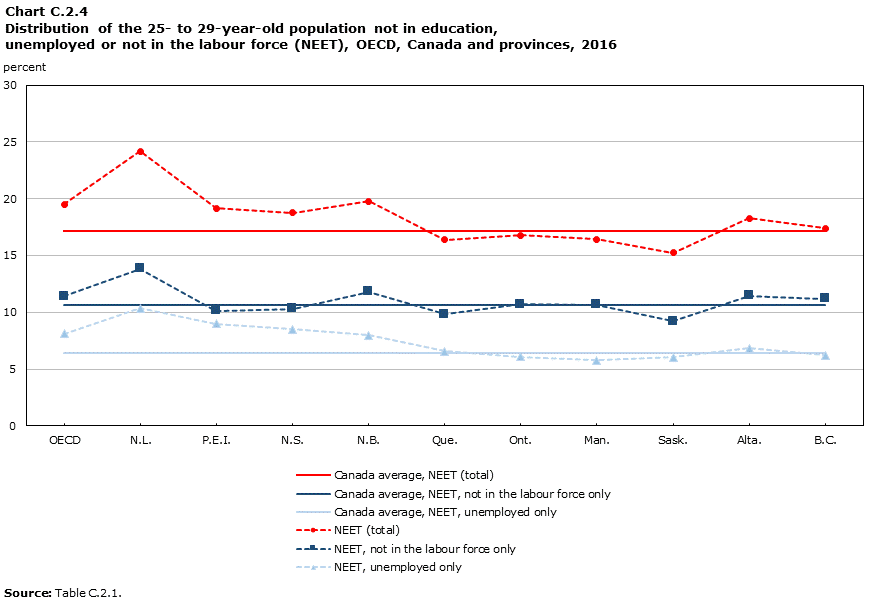
Data table for Chart C.2.4
| NEET, unemployed only | NEET, not in the labour force only | NEET (total) | Canada average, NEET, unemployed only | Canada average, NEET, not in the labour force only | Canada average, NEET (total) | |
|---|---|---|---|---|---|---|
| percent | ||||||
| OECD | 8.1 | 11.4 | 19.5 | 6.4 | 10.7 | 17.1 |
| Can. | 6.4 | 10.7 | 17.1 | 6.4 | 10.7 | 17.1 |
| N.L. | 10.4 | 13.8 | 24.2 | 6.4 | 10.7 | 17.1 |
| P.E.I. | 9.0 | 10.1 | 19.1 | 6.4 | 10.7 | 17.1 |
| N.S. | 8.5 | 10.3 | 18.8 | 6.4 | 10.7 | 17.1 |
| N.B. | 8.0 | 11.8 | 19.8 | 6.4 | 10.7 | 17.1 |
| Que. | 6.6 | 9.8 | 16.4 | 6.4 | 10.7 | 17.1 |
| Ont. | 6.1 | 10.7 | 16.8 | 6.4 | 10.7 | 17.1 |
| Man. | 5.8 | 10.7 | 16.4 | 6.4 | 10.7 | 17.1 |
| Sask. | 6.0 | 9.2 | 15.2 | 6.4 | 10.7 | 17.1 |
| Alta. | 6.8 | 11.4 | 18.3 | 6.4 | 10.7 | 17.1 |
| B.C. | 6.2 | 11.2 | 17.4 | 6.4 | 10.7 | 17.1 |
| Source: Table C.2.1. | ||||||
- In 2016, as in previous years, the young NEET population (unemployed or not in the labour force) was highest among Canadians aged 25 to 29, at 17%. Within this age group, more were not in the labour force (11%) than unemployed (6%). This same trend was observed in all provinces and in the OECD average.
Not employed, not in education (NEET) by sex
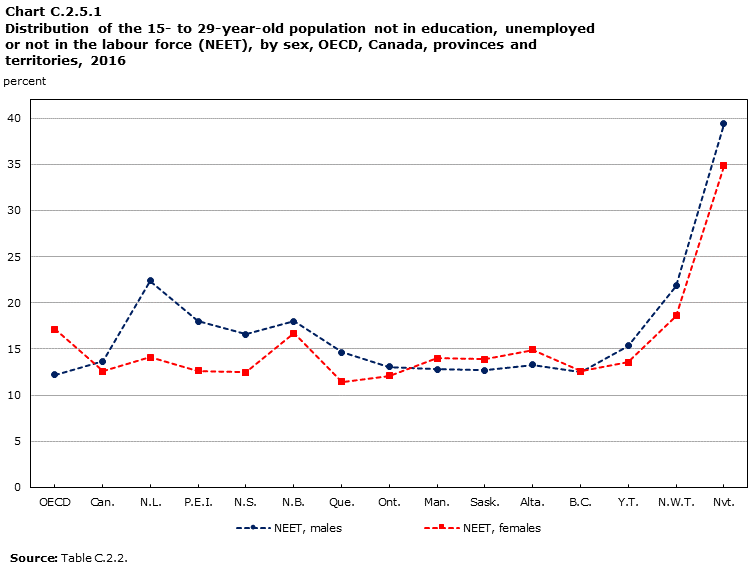
Data table for Chart C.2.5.1
| NEET, males | NEET females | |
|---|---|---|
| percent | ||
| OECD | 12.2 | 17.1 |
| Can. | 13.6 | 12.6 |
| N.L. | 22.4 | 14.1 |
| P.E.I. | 18.0 | 12.6 |
| N.S. | 16.6 | 12.5 |
| N.B. | 18.0 | 16.7 |
| Que. | 14.6 | 11.4 |
| Ont. | 13.1 | 12.1 |
| Man. | 12.8 | 14.0 |
| Sask. | 12.7 | 13.9 |
| Alta. | 13.3 | 14.9 |
| B.C. | 12.5 | 12.6 |
| Y.T. | 15.3 | 13.5 |
| N.W.T. | 21.9 | 18.6 |
| Nvt. | 39.4 | 34.8 |
| Source: Table C.2.2. | ||
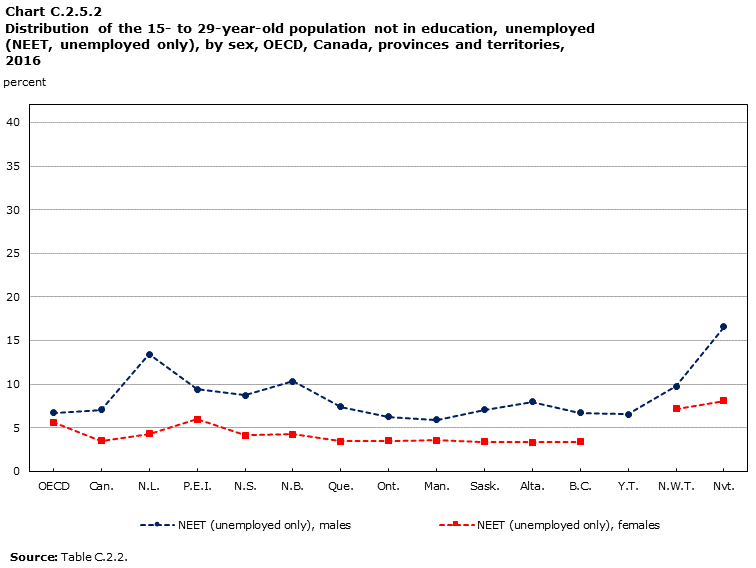
Data table for Chart C.2.5.2
| NEET (unemployed only), males | NEET (unemployed only) females | |
|---|---|---|
| percent | ||
| OECD | 6.7 | 5.6 |
| Can. | 7.0 | 3.5 |
| N.L. | 13.4 | 4.3 |
| P.E.I. | 9.4 | 6.0 |
| N.S. | 8.7 | 4.2 |
| N.B. | 10.3 | 4.2 |
| Que. | 7.4 | 3.5 |
| Ont. | 6.2 | 3.5 |
| Man. | 5.9 | 3.6 |
| Sask. | 7.0 | 3.4 |
| Alta. | 8.0 | 3.3 |
| B.C. | 6.7 | 3.4 |
| Y.T. | 6.5 | X |
| N.W.T. | 9.8 | 7.2 |
| Nvt. | 16.6 | 8.1 |
|
X suppressed to meet the confidentiality requirements of the Statistics Act Source: Table C.2.2. |
||
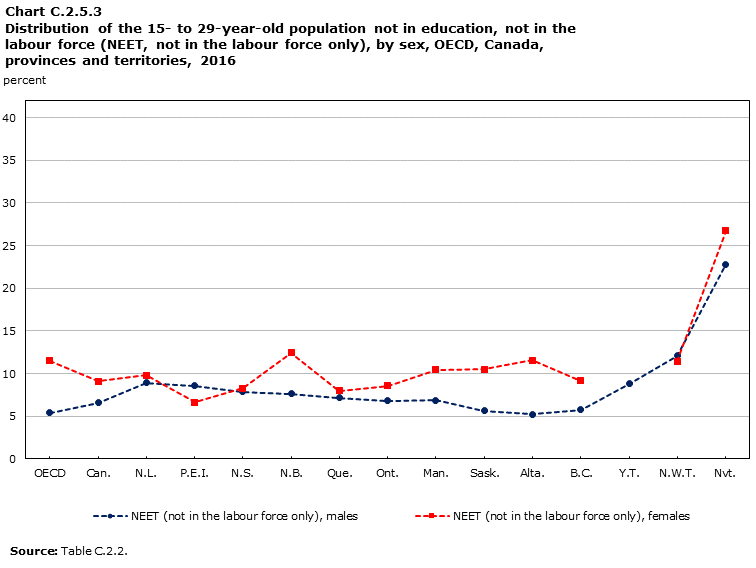
Data table for Chart C.2.5.3
| NEET (not in the labour force only), males | NEET (not in the labour force only) females | |
|---|---|---|
| percent | ||
| OECD | 5.4 | 11.5 |
| Can. | 6.6 | 9.1 |
| N.L. | 8.9 | 9.8 |
| P.E.I. | 8.6 | 6.7 |
| N.S. | 7.9 | 8.3 |
| N.B. | 7.7 | 12.4 |
| Que. | 7.2 | 8.0 |
| Ont. | 6.8 | 8.6 |
| Man. | 6.9 | 10.4 |
| Sask. | 5.6 | 10.5 |
| Alta. | 5.3 | 11.6 |
| B.C. | 5.8 | 9.2 |
| Y.T. | 8.8 | X |
| N.W.T. | 12.1 | 11.4 |
| Nvt. | 22.8 | 26.7 |
|
X suppressed to meet the confidentiality requirements of the Statistics Act Source: Table C.2.2. |
||
- In 2016, there was little variation between women (13%) and men (14%) in the 15-to-29 age group for the Canadian average of young NEETs, as shown in Chart C.2.5.1. The same was true for most of the provinces and territories, except Newfoundland and Labrador, Prince Edward Island, Nova Scotia and Nunavut as well as the OECD average, where the difference between women and men was greater than four percentage points.
- When unemployed individuals and those not in the labour force in the young NEET population were examined separately (charts C.2.5.2 and C.2.5.3), we found that, for the Canadian average, a greater proportion of women (9%) than men (7%) were not in the labour force, whereas more men (7%) than women (3%) were unemployed. With the exception of Prince Edward Island and the Northwest Territories, this trend was observed in all provinces and territories and in the OECD average.
Combining work and school
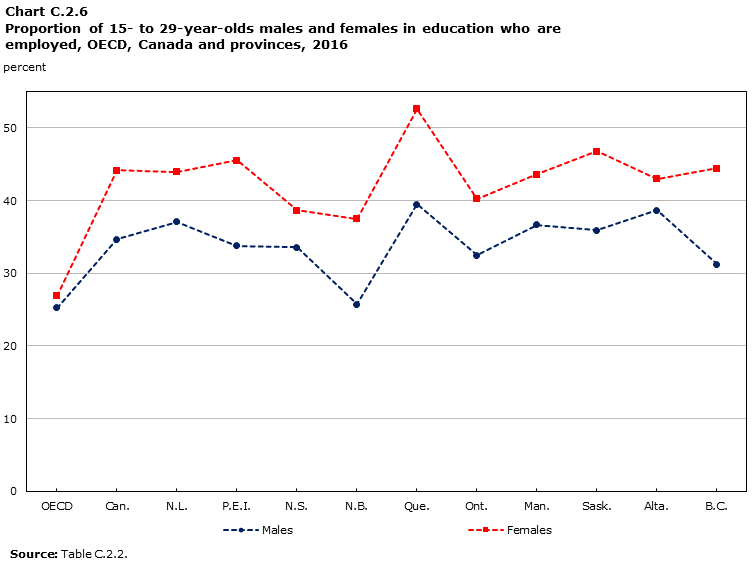
Data table for Chart C.2.6
| Males | Females | |
|---|---|---|
| percent | ||
| OECD | 25.3 | 26.9 |
| Can. | 34.7 | 44.2 |
| N.L. | 37.1 | 43.9 |
| P.E.I. | 33.8 | 45.6 |
| N.S. | 33.6 | 38.7 |
| N.B. | 25.7 | 37.5 |
| Que. | 39.5 | 52.6 |
| Ont. | 32.5 | 40.2 |
| Man. | 36.7 | 43.6 |
| Sask. | 35.9 | 46.8 |
| Alta. | 38.7 | 43.0 |
| B.C. | 31.3 | 44.5 |
| Source: Table C.2.2. | ||
- In Canada in 2016, a greater proportion of women (44%) than men (35%) aged 15 to 29 years were working while in school.Note 6 This trend, which has persisted for several years, is noted in other publicationsNote 7 and is observed in all the provinces as well as in the OECD average.
Definitions, sources and methodology
The indicator is calculated using cross-tabulations for the following variables: school attendance, labour force status, sex, age (15 to 29 overall; 15 to 19; 20 to 24; and 25 to 29) and educational attainment (highest level of education attained). Individuals are categorized by their education status (in education or not in education) and their labour force status (employed, unemployed, or not in the labour force). Some historical data are also presented.
The “in education” group captures both full- and part-time students, while “not in education” portrays those who are no longer pursuing a formal education. As per the OECD definition, the educational institutions considered for this indicator are primary and secondary educational institutions, colleges and universities. Employment status is based on International Labour Organization (ILO) guidelines. The employed are defined as those who during the survey reference week: (i) work for pay (employees) or profit (self-employed and unpaid family workers) for at least one hour; or (ii) have a job but are temporarily not at work (through injury, illness, holiday, strike or lock-out, educational or training leave, maternity or parental leave, etc.). The unemployed are defined as individuals who are, during the survey reference week, without work, actively seeking employment and currently available to start work. And not in the labour force captures individuals who are not working and who are not unemployed; i.e., individuals who are not looking for a job.
In addition to those who are employed, the total “not in education” portion of the 15- to 29-year-old population also includes those who are neither employed nor in education (or training). Such individuals are sometimes referred to as the “NEET” population. This captures a somewhat diverse group of young people in a number of possible situations. Some may be part of this group by choice, perhaps taking time off work and/or school to travel or to start families and care for their young children. Some might prefer to be working, but have abandoned the job search temporarily. These people would be seen as “not in the labour force”Note 8 as opposed to those who are seeking work but are unemployed. The group of people who are not in education and are either “unemployed” or “not in the labour force” is a population that could potentially be at risk for economic and social difficulties.
The data were obtained from Statistics Canada’s Labour Force Survey (LFS), and they cover the first quarter or the average of the first three months of the calendar year, which excludes summer employment. The LFS does not collect data on official work-study programmes in which students might participate; in Canada, these would be considered education in the form of a co-op or student intern programme.
Note: The corresponding OECD indicator is C5, Transition from school to work: Where are the 15-29 year-olds?
- Date modified:
